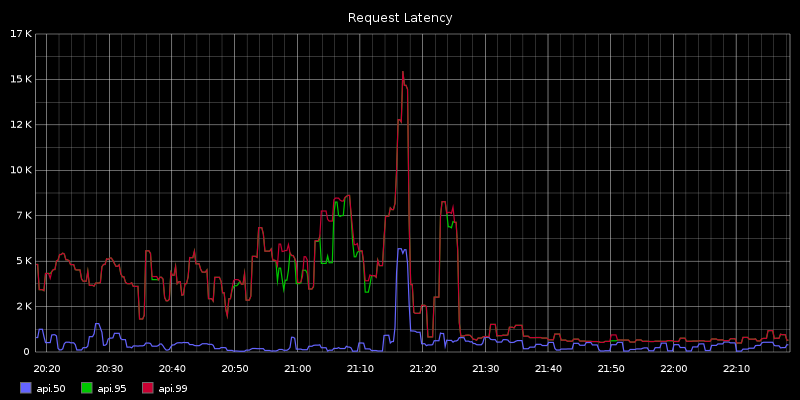Most applications have configuration: how to open a connection to the database, what file to log to, the locations of key data files, etc.
Configuration is hard to express correctly. It’s dynamic because you don’t know the configuration at compile time–instead it comes from a file, the network, command arguments, etc. Config is almost always implicit, because it affects your functions without being passed in as an explicit parameter. Most languages address this in two ways:
Globals
As a quick follow-up, I managed to squeeze an extra 10% or so out of riemann.server by adding a few type hints.


I’ve been focusing on Riemann client libraries and optimizations recently, both at Boundary and on my own time.
Boundary uses the JVM extensively, and takes advantage of Coda Hale’s Metrics. For our applications I’ve written a Riemann Java UDP and TCP client, which also includes a Metrics reporter. The Metrics reporter (I’ll be submitting that to metrics-contrib later) will just send periodic events for each of the metrics in a registry, and optionally some VM statistics as well. It can prefix each service, filter with predicates, and has been reporting for two of our production systems for about a week now.
The Java client has been integrated into Riemann itself, replacing the old Aleph client. It’s about on par with the old Aleph client, owing to its use of standard Socket and friends as opposed to Netty. Mårten Gustafson and Edward Ribeiro have been instrumental in getting the Java client up and running, so my sincere thanks go out to both of them.
The initial stable release of Riemann 0.1.0 is available for download. This is the culmination of the 0.0.3 development path and 2 months of production use at Showyou.
Is it production ready? I think so. The fundamental stream operators are in place. A comprehensive test suite checks out. Riemann has never crashed. Its performance characteristics should be suitable for a broad range of scales and applications.
There is a possible memory leak, on the order of 1% per day in our production setup. I can’t replicate it under a variety of stress tests. It’s not clear to me whether this is legitimate state information (i.e. an increase in tracked data), GC/malloc implementations being greedy, or an actual memory leak. Profiling and understanding this is my top priority for Riemann. If this happens to you, restarting the daemon every few weeks should not be prohibitive; it takes about five seconds to reload. Should you encounter this issue, please drop me a line with your configuration; it may help me identify the cause.
When I designed UState, I had a goal of a thousand state transitions per second. I hit about six hundred on my Macbook Pro, and skirted 1000/s on real hardware. Eventmachine is good, but I started to bump up against concurrency limits in MRI’s interpreter lock, my ability to generate and exchange SQL with SQLite, and protobuf parse times. So I set out to write a faster server. I chose Clojure for its expressiveness and powerful model of concurrent state–and more importantly, the JVM, which gets me Netty, a mature virtual machine with a decent thread model, and a wealth of fast libraries for parsing, state, and statistics. That project is called Riemann.
Today, I’m pleased to announce that Riemann crossed the 10,000 event/second mark in production. In fact it’s skirting 11k in my stress tests. (That final drop in throughput is an artifact of the graph system showing partially-complete data.)

Microsoft released this little gem today, fixing a bug which allowed remote code execution on all Windows Vista, 6, and Server 2008 versions.
...allow remote code execution if an attacker sends a continuous flow of specially crafted UDP packets to a closed port on a target system.
Meanwhile, in an aging supervillain’s cavernous lair…
Major thanks to John Muellerleile (@jrecursive) for his help in crafting this.
Actually, don’t expose pretty much any database directly to untrusted connections. You’re begging for denial-of-service issues; even if the operations are semantically valid, they’re running on a physical substrate with real limits.
Riak, for instance, exposes mapreduce over its HTTP API. Mapreduce is code; code which can have side effects; code which is executed on your cluster. This is an attacker’s dream.
As a part of the exciting series of events (long story…) around our riak cluster this week, we switched over to riak-pipe mapreduce. Usually, when a node is down mapreduce times shoot through the roof, which causes slow behavior and even timeouts on the API. Riak-pipe changes that: our API latency for mapreduce-heavy requests like feeds and comments fell from 3-7 seconds to a stable 600ms. Still high, but at least tolerable.

[Update] I should also mention that riak-pipe MR throws about a thousand apparently random, recoverable errors per day. Things like map_reduce_error with no explanation in the logs, or {“lineno”:466,“message”:“SyntaxError: syntax error”,“source”:“()”} when the source is definitely not “()”. Still haven’t figured out why, but it seems vaguely node-dependent.
Do you really want to be contributing to an open source effort? ... Don't be risking your data on NoSQL databases.
Says the company which is scheduling talks around Oracle NoSQL at its OpenWorld conference.
[Edit] Their whitepaper on Oracle NoSQL DB is a hilarious inversion of the above.


